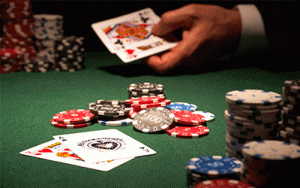Learn casino history by reading about the origins of casino gambling, where it all began and how!
Many various casino attitudes were enforced because entire colonies were established along the guidelines and beliefs of one group or another. In New England and Pennsylvania, Puritan attitudes toward casino gaming and play were adopted and they outlawed the possession of cards, dice, and gaming tables (even in private homes).
In other colonies, English attitudes towards casino gambling and recreation prevailed. These settlers brought with them the view that gambling was a harmless diversion and gambling became a popular and accepted activity. But casino gambling began to be blamed for the problems of the colonies. To investors and others in England these suggested an atmosphere of idleness and vice. Financiers began to suspect that beause of such casino playing the colonies weren’t able to sustain themselves.
Casino Gambling
 Casino gaming started slowly. Taverns and roadhouses would allow dice and casino card games. The relatively sparse population was a barrier to establishing casino houses. But as the population increased, by the early 1800s many a lavish casino was established.
Casino gaming started slowly. Taverns and roadhouses would allow dice and casino card games. The relatively sparse population was a barrier to establishing casino houses. But as the population increased, by the early 1800s many a lavish casino was established.
During the early 1800s casino gambling in the lower Mississippi Valley became a legitimate enterprise. The Mississippi River and connected waterways were major avenues of trade for farmers and merchants and the river boats carried passengers who had lots of cash. The south tended to have a more open attitude towards gaming, reflecting the Spanish, French, and early Virginian traditions.
New Orleans became the capital for casino playing. Many a casino was started in the river towns and became popular haunts for both travelers and professional casino players. These gamblers preyed upon these cash-laden travelers.
Gambling Card Sharks
These professional casino gamblers, also known as sharps or sharpers, were usually dishonest and often turned to confidence games and cheating to make money. During the 1830’s, professional casino players came under growing scrutiny and southern settlers turned against them. These professional casino gamblers were blamed for limiting economic growth, interfering with business, endangering the streets, committing numerous crimes, and debasing the morality of the society. Vigilantism was one method by which the anti-professional gambler sentiment manifested itself. Groups of citizens organized to push the gamblers out of the South. In 1835, a vigilante group lynched five cardsharps in Mississippi. Professional casino gamblers moved from the town into the riverboats. Lynching proved to be a successful policy option for reducing the presence of professional gamblers.
River Boat Gambling
In contrast to a river boat casino of today, the old-time river boats were not floating casinos. Casino playing occurred informally among the passengers. The period between 1840 and 1860 represented the glory days of the flashy riverboat gambler. The professional casino players also moved to California.
The demise of the casino riverboat gambler had more to do with the emergence of railroads and the outbreak of the Civil War. Travel by steamboats declined as railroads started to supplant steamboats as the favored method of transportation. Trains were more reliable and were faster than the riverboats. The Civil War interrupted virtually all river travel and abruptly diminished gambling in that area.
Frontier Gambling
The frontier areas, California included, saw a great deal of casino playing. Because of the wholesale fraud, lotteries were targeted for prohibition, but casino playing in posh clubs were still legal in New York. Horse racing survived the end of the first wave relatively unscathed. It was also during this time that the Grimaldis sold a casino concession in an attempt to keep their principality, Monaco, from going bankrupt. Monte Carlo was opened in 1858 by casino operators who had been forced to leave Hamburg, Germany after popular opinion turned against gambling.
The California Gold Rush
 The public disfavor in Germany occurred because of the charge that legalized casino playing was turning the city into a nest of paupers. The California Gold Rush set off a casino boom. San Francisco replaced New Orleans as the casino center. The market for casino space was so strong that a mere canvas tent cost $40,000 annually, payable in advance with gold dust. The apex of California casino playing was from 1849 to 1855 and it became widespread throughout the state.
The public disfavor in Germany occurred because of the charge that legalized casino playing was turning the city into a nest of paupers. The California Gold Rush set off a casino boom. San Francisco replaced New Orleans as the casino center. The market for casino space was so strong that a mere canvas tent cost $40,000 annually, payable in advance with gold dust. The apex of California casino playing was from 1849 to 1855 and it became widespread throughout the state.
By 1850, both the state and cities were licensing casino establishments to raise money. As settlers spread beyond California, so did casino places. In general, gambling and the west were intimately linked. Casino playing was especially widespread in the mining camps that multiplied as the miners spread across the west searching for new strikes.
Gambling Laws
Laws against casino players and casinos began to be enacted in California. As with the rest of the United States, the desire for respectability and a recognition of the social ills tied to gaming led to limits on casino establishments. The Legislature made most types of casino playing illegal. However, the Legislature’s initial aim was more to target the professional casino player than gaming in general. Gamblers were affiliated with municipal corruption and were blamed for the depression that was occurring at the time.
Initially, the state laws were weak and had little real effect on casino playing. The statutes outlawed specific games, making the laws difficult to enforce as new and unnamed casino variants were used and only light penalties were provided. However, the laws were gradually strengthened. In 1860, all banking casino games were banned. (Banking games are those where the player bets against the house.) Initially, the laws tended to focus on those who ran the casino and not the players. In 1885, this was changed so that it was illegal to play. Finally in 1891, the statutes made the penalty for playing equal to the penalty for running the game.
Prohibition did not eliminate casino betting but instead it went underground. Even in California, where most casino playing was illegal, the first slot machine was in San Francisco in 1895.17 It was not specifically outlawed until 1911.
Gambling in Nevada
Nevada bounced between legalizing and banning casino gaming. Casino betting was legal in Nevada between 1869 and 1910. As a result, casino activity moved from California to places such as Virginia City, Nevada. Although legally protected, during this time casino gambling never reached the size in Nevada that it did in San Francisco.
Chinese Gambling
Another effect of the anti-casino laws was to stratify gaming activity more. One result was the prevalence of Chinese casino houses that catered only to Chinese. There were also large Chinese-run lotteries that appealed to non-Chinese. Enforcement of the casino laws became a method of discrimination. During times of strong anti-Chinese sentiment the casino laws were enforced more vigorously against Chinese establishments.
Gambling Prohibitions
Scandals and the rise of Victorian morality led to the end of legal casino playing. By 1910, virtually all forms of casino betting were prohibited in the U.S. The only legal betting that occurred was in three states which allowed horse racing, but even that number shrank in the ensuing years.
The feelings against casino betting ran so strong that Arizona and New Mexico were forced to outlaw casino wagering to gain statehood. However, the prohibition did not stop casinos. There were many types of illegal casino houses. Some operated openly for many years. They, of course, had to pay protection money to the law enforcement authorities. The great depression led to a much greater legalization of gambling.
Financial Distress
T he antigambling mood changed as tremendous financial distress gripped the country, especially after the stock market crash of 1929. Legalized gambling was looked upon as a way to stimulate the economy. Massachusetts decriminalized bingo in 1931 in an attempt to help churches and charitable organizations raise money. Bingo was legal in 11 states by the 1950s, usually only for charity purposes. Horse racing and parimutuel wagering began to make a comeback. In 1933, Michigan, New Hampshire, Ohio, and California legalized parimutuel betting.
he antigambling mood changed as tremendous financial distress gripped the country, especially after the stock market crash of 1929. Legalized gambling was looked upon as a way to stimulate the economy. Massachusetts decriminalized bingo in 1931 in an attempt to help churches and charitable organizations raise money. Bingo was legal in 11 states by the 1950s, usually only for charity purposes. Horse racing and parimutuel wagering began to make a comeback. In 1933, Michigan, New Hampshire, Ohio, and California legalized parimutuel betting.
The Horse Racing Act
The California Legislature adopted a statute in 1933 referred to as the Horse Racing Act. The statutes took effect upon adoption by the voters of an amendment to the Constitution in June of 1933. During the 1930’s, 21 states brought back racetracks. New laws and automated systems made horse racing much more honest than during the 1800s.
The crackdown in the east had implications for California. Because of the pressure from law enforcement agencies, New York mobsters, including the infamous Benjamin “Bugsy” Siegel, moved to the West Coast. His role was to expand gaming and bookmaking operations for organized crime. Eventually, publicity was directed on him during an investigation of mob ties with the film unions, forcing him to move to Las Vegas.
Floating Casinos
At the same time, scrutiny also resulted in the closing of the floating casinos. The most famous was the Rex, a floating casino operated by organized crime that was anchored just outside the three-mile limit of state jurisdiction. Gamblers were taken out to Rex in excursion boats. The Rex and some gaming ships that operated out of San Francisco Bay were eventually closed down by law enforcement authorities.
Bugsy Siegal’s Gambling Legacy
Nevada legalized many forms of casino playing in 1931. Nevada had a flourishing, albeit illegal, gambling industry prior to the legalization. The move for making gambling legal also grew out of concerns that the flourishing illegal gambling was corrupting law enforcement and prohibition was unenforceable. Gaming in Nevada struggled from its inception until after World War II, when the prosperity of post-war America started a boom in the fledgling industry.
Many casinos in Nevada were financed by mobsters. Most notable perhaps was Las Vegas’ Flamingo which was opened in 1947 by Bugsy Siegel. Even though he had an extensive and violent criminal record, Bugsy Siegel was able to get a gaming license. Today, even the hint of any such activity would be sufficient to deny a license.
Part of the reason for Mr. Siegel’s success was due to his connection to the underworld. Wartime shortages did not slow down his plans because of his ties to the black market and his political connections. The lavish casino he built opened with such stars as Jimmy Durante, Xavier Cougat, and George Raft. The Flamingo helped establish Las Vegas, rather than Reno, as the destination for high rollers. Reportedly Mr. Siegel used too much of the mob’s money on what was initially a unprofitable operation. Within the year, Mr. Siegel was gunned down at a Beverly Hills mansion. Eventually, the mob sold their casino interests to lawful individuals and publicly-traded companies.